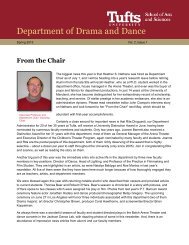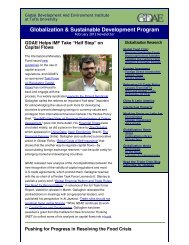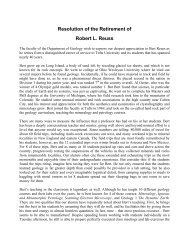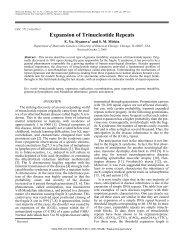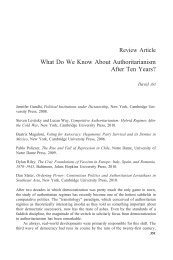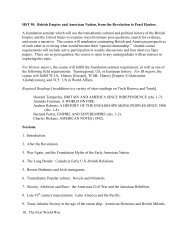Is A Main Street Program Appropriate for Mattapan? - Tufts University
Is A Main Street Program Appropriate for Mattapan? - Tufts University
Is A Main Street Program Appropriate for Mattapan? - Tufts University
Create successful ePaper yourself
Turn your PDF publications into a flip-book with our unique Google optimized e-Paper software.
to expect more from <strong>Main</strong> <strong>Street</strong>s . To Goerhing, “Many community organizations<br />
is a positive . It makes things more complicated- but it is a huge<br />
benefit .” Four Corners has not been as good at recruiting residents, and she<br />
feels having neighborhood organizations could really help .<br />
St . Mark’s <strong>Main</strong> <strong>Street</strong> (SMMS) has been quite successful in working with<br />
community organizations . Executive Director Dan Larner listed one of the<br />
greatest strengths of his program is its ability to get the people in the neighborhood<br />
involved and to take an interest in the business district . Larner<br />
attends each group’s meeting 1-2 times per year in addition to keeping in<br />
regular contact with each . He did note that it helps that in the St . Mark’s<br />
neighborhood, the civic organizations all get along relatively well . SMMS<br />
has focused on large-development projects along Dorchester Avenue . An<br />
executive director of a nearby district highlighted the geographic advantage<br />
of SMSS’s development projects . The territory of each community group<br />
in St . Mark’s borders Dorchester Avenue . This means that no one group<br />
“owns” the territory where the major development projects are taking place .<br />
“Many community organizations is a positive. It makes<br />
things more complicated--but it is a huge benefit.”<br />
Linda Rubin Royer, the new executive director of Washington Gateway<br />
<strong>Main</strong> <strong>Street</strong>s, contends that the eight neighborhood groups in her area have<br />
been assets . “I can learn stuff from [our local organizations] . I learn what<br />
is important to them…but we have to remember that we are an economic<br />
development organization, and we are pro-business .” The importance of<br />
remaining close to the mission was echoed by Clark Moulaison, Executive<br />
Director of East Boston <strong>Main</strong> <strong>Street</strong>s who warns, “Along may come a<br />
children’s organization…and your <strong>Main</strong> <strong>Street</strong>s decides to help . You should<br />
support them but don’t take away from your mission . Stay focused on the<br />
commercial district, promoting local business, etc . <strong>Main</strong> <strong>Street</strong>s does have<br />
its limitations .” The need to choose a simple mission and commit to it was<br />
echoed by many of the directors . As <strong>Main</strong> <strong>Street</strong>s is a comprehensive approach<br />
there is a danger in it focusing on projects beyond its scope .<br />
Getting the Business Community on Board<br />
A significant struggle <strong>for</strong> many districts was convincing business owners to<br />
participate in <strong>Main</strong> <strong>Street</strong>s . Some executive directors felt it was a cultural<br />
issue -- while a storefront may seem shabby to one business owner, to<br />
another it was okay, so there was no motivation to make improvements .<br />
Other executive directors felt the lack of buy-in is the result of the business<br />
owners being focused on surviving today and not seeing the bigger picture<br />
and how their contribution to <strong>Main</strong> <strong>Street</strong>s could help them in the long term .<br />
A common perception that does not help with bringing business owners<br />
on board is the idea that the executive directors are city employees out to<br />
28<br />
report them <strong>for</strong> infractions . Business owners do not always understand that<br />
the <strong>Main</strong> <strong>Street</strong> districts are separate non-profit entities . Almost all of the<br />
executive directors reported that this issue occurs in their neighborhoods<br />
and almost all confirmed that they had never reported a business to city’s<br />
Department of Inspectional Services, or if they had, it was a rarity .<br />
When asked how they try to break down such a barrier, nearly all cited the<br />
need the need to be “visible and on the ground .” Many talked about how<br />
they spend time just walking the streets, saying hello and getting to know<br />
the businesses . They list this as one of the most important steps towards<br />
bringing businesses on board . Zachary Cohen of Upham’s Corner said ,, “I<br />
spent the first six months going door-to-door, talking with business owners .<br />
Find out what they are doing, what they need . You can tell if they don’t like<br />
you and then that is when you really need to concentrate on them . If you<br />
listen then they will turn around . For the first six months you are just listening<br />
and not doing anything .”<br />
Other tactics to bring businesses on board include offering promotion along<br />
with business membership . If businesses become a member of the Hyde<br />
Park <strong>Main</strong> <strong>Street</strong>s, the Executive Director Patrice Latozi will write an article<br />
about them in their monthly newsletter or post something on the website .<br />
While in the past they have used a directory to promote businesses, there is<br />
not enough funding this year . Instead, she is putting an ad in the Shopper,<br />
which goes out to 11,000 homes thanking each of her business members .<br />
Business networking events have been another successful tool used in<br />
Hyde Park, East Boston and Upham’s Corner . Hyde Park <strong>Main</strong> <strong>Street</strong>s<br />
hosts monthly business networking breakfasts year-round, except <strong>for</strong> two<br />
months in the summer . Upham’s Corner <strong>Main</strong> <strong>Street</strong>s recently began hosting<br />
business networking breakfasts . They are held bi-monthly and often<br />
have speakers that discuss development projects in the area . The number<br />
of businesses has grown from 24 to 70, and Mayor Menino has even<br />
attended . East Boston <strong>Main</strong> <strong>Street</strong>s (EBMS) has also held six networking<br />
events in collaboration with the chamber of commerce . Over 125 businesses<br />
participated in addition to local police, state representatives, and<br />
city councilors . They gave the business owners a survey and had a brainstorming<br />
session . Moulaison commented, “It was a great success because<br />
we invited everyone in and just said, ‘what’s on your mind?’ .” The events<br />
led EBMS to help individual businesses with some small problems, which<br />
allowed them to show that they can take direct action that leads to visible<br />
results .<br />
Long-Term Projects vs. Short Winds<br />
Many of the districts have had success with large-scale development projects<br />
. Washington Gateway <strong>Main</strong> <strong>Street</strong> has been heralded as having played<br />
a pivotal role in the trans<strong>for</strong>mation of the South End with its involvement




